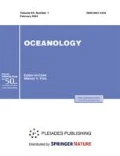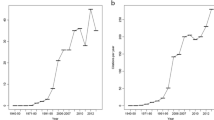Abstract
An analysis of published and original data on the meiobenthos abundance in the depth interval from 100 to 9807 m (in total, 665 records, 445 of them obtained for depths exceeding 1000 m) revealed general regularities in its distribution. The influence of the sampling and data processing methods on the quantitative estimates of the meiobenthos abundance is considered to demonstrate changes in the proportions of the main meiobenthic taxa at different depths and to characterize latitudinal changes in the meiobenthos abundance. The dependence of the abundance of free-living nematodes, the most abundant group of metazoan meiobenthos, on trophic conditions is analyzed. No significant differences in the meiobenthos abundance in the samples obtained by box-and multicorers are established. It is shown that the share of nematodes in metazoan meiobenthos communities increases with the depth. In temperate latitudes, a distinct maximum in the population density confined to depths exceeding 1 km is observed. The quantitative distribution of the meiobenthos at the depths gradient is controlled by the bottom macrotopography and trophic conditions.
Similar content being viewed by others
References
I. V. Burkovskii, A. P. Stolyarov, and M. Yu. Kolobov, “Spatial Organization and Functioning of a Marine (Estuarine) Ecosystem,” Usp. Sovrem. Biol. 122(4), 316–325 (2002).
L. A. Zenkevich, Z. A. Filatova, G. M. Belyaev, et al., “Quantitative Distribution of Zoobenthos in the World Ocean,” Byull. MOIP, Otd. Biol, No. 3, 27–33 (1971).
V. O. Mokievskii, A. A. Udalov, and A. I. Azovskii, “On the Quantitative Distribution of Meiobenthos on the Shelf of the World Ocean,” Okeanologiya 44(1), 110–120 (2004) [Oceanology 44 (1), 99–109 (2004)].
E. A. Romankevich, Geochemistry of Organic Matter in the Ocean (Nauka, Moscow, 1977) [in Russian].
A. A. Udalov, I. V. Burkovskii, A. I. Azovskii, and E. S. Chertoprud, “Effect of Experimental Increase of Meiobenthos Density on the Estuarine Intertidal Community in the White Sea,” Okeanologiya 42(1), 106–115 (2002) [Oceanology 42 (1), 99–108 (2002)].
D. M. Alongi, “Intertidal Zonation and Seasonality of Meiobenthos in Tropical Mangrove Estuaries,” Mar. Biol. 95, 447–458 (1987).
D. M. Alongi, “Bathymetric Patterns of Deep-Sea Benthic Communities from Bathyal to Abyssal Depths in the Western South Pacific (Solomon and Coral Seas),” Deep-Sea Res. 39, 549–565 (1992).
D. M. Alongi and M. Pichon, “Bathyal Meiobenthos of the Western Coral Sea: Distribution and Abundance in Relation to Microbial Standing Stocks and Environmental Factors,” Deep-Sea Res. Ser. A: Oceanography Research Papers 35(4), 491–503 (1988).
S. Ankar and R. Elmgren, “The Benthic Macro-and Meiofauna of the Asko-Landsort area (Northern Baltic Proper): A Stratified Random Sampling Survey,” Contributions from the Asko Laboratory 11, 11–15 (1976).
Z. A. Anzari, “Distribution of Deep-Sea Benthos in the Proposed Mining Area of Central Indian Basin,” Marine Georesources and Geotechnology 18, 201–207 (2000).
Z. A. Ansari, A. H. Parulekar, and T. G. Jagtap, “Distribution of Sub-Littoral Meiobenthos off Goa Coast, India,” Hydrobiologia 74(3), 209–214 (1980).
H. Asmus and R. Asmus, “Trophic Relationships in Tidal Flat Areas: To What Extent Are Tidal Flats Dependent on Imported Food?” Neth. J. Sea Res. 27(1), 93–99 (1990).
G. Auffret, “Environnement Morphologique et Sedimentologique,” in Peuplements Profonds du Golfe de Gascogne, Ed. by L. Laubier and C. Monniot (IFREMER, Paris, 1985) pp. 43–70.
M. C. Austen, “Factors Affecting Estuarine Meiobenthic Assemblage Structure: A Multifactorial Microcosm Experiment,” J. Exp. Mar. Biol. Ecol. 130(2), 167–187 (1989).
M. C. Austen and R. M. Warwick, “Effects of Manipulation of Food Supply on Estuarine Meiobenthos,” Hydrobiologia 311(1–3), 175–184 (1995).
P. R. O. Barnett, J. Watson, and D. Conelly, “A Multiple Corer for Taking Virtually Undisturbed Samples from Shelf, Bathyal, and Abyssal Sediments,” Oceanol. Acta 7, 399–408 (1984).
W. H. Berger, “Global Maps of Ocean Productivity,” in Productivity of the Ocean: Past and Present (Dahlem Workshop Repot 44), Ed. by W. H. Berger et al. (John Wiley, Chichester, 1989), pp. 429–455.
B. J. Bett, A. Vanreusel, M. Vincx, et al., “Sampler Bias in the Quantitative Study of Deep-Sea Meiobenthos,” Marine Ecology Progress Series 104, 197–203 (1994).
D. S. M. Billett, R. S. Lampitt, A. L. Rice, and R. C. F. Mantoura, “Seasonal Sedimentation of Phytoplankton to the Deep-Sea Benthos,” Nature 302, 520–522 (1983).
A. Boetius, S. Scheibe, A. Tselepides, and H. Thiel, “Microbial Biomass and Activities in Deep-Sea Sediments of the Eastern Mediterranean: Trenches Are the Benthic Hotspots,” Deep-Sea Res. 43, 1439–1460 (1996).
R. Danovaro, C. Gambi, and Croce N. Della, “Meiofauna Hotspot in the Atacama Trench, Eastern South Pacific Ocean,” Deep-Sea Res. 49 Part I, 843–857 (2002).
R. Danovaro, A. Tselepides, A. Otegui, and Croce N. Della, “Dynamics of Meiofaunal Assemblages on the Continental Shelf and Deep-Sea Sediments of the Cretan Sea (NE Mediterranean): Relationships with Seasonal Changes in Food Supply,” Progr. Oceanogr. 46, 367–400 (2000).
J. W. Deming and J. A. Baross, “The Early Diagenesis of Organic Matter: Bacterial Activity,” in Organic Geochemistry: Principles and Applications, Ed. by M. H. Engel and S. Macko (Plenum, New York, 1993), pp. 119–144.
K. O. Emery and E. Uchupi, The Geology of the Atlantic Ocean (Springer, New York, 1984).
J. Galleron, M. Sibuet, M. L. Mahaut, and A. Dinet, “Variation in Structure and Biomass of the Benthic Communities at Three Contrasting Sites in the Tropical Northeast Atlantic,” Marine Ecology Progress Series 197, 121–137 (2000).
A. J. Gooday, “Meiofaunal Foraminiferas from the Bathyal Porcupine Seabight: Size Structure, Taxonomic Composition, Species Diversity, and Vertical Distribution in the Sediment,” Deep-Sea Res. 33, 1345–1372 (1986).
A. J. Gooday, A. J. Hughes, and L. A. Levin, “The Foraminiferal Macrofauna from Three North Carolina (USA) Slope Sites with Contrasting Carbon Flux: A Comparison with the Metazoan Macrofauna,” Deep-Sea Res. 48 Part I, 1709–1739 (2001).
B. S. Ingole, Z. A. Anzari, V. Rathod, and N. Rodrigues, “Responce of Meiofauna to Immediate Benthic Disturbance in the Central Indian Ocean Basin,” Marine Georesourses and Geotechnology 18, 263–272 (2000).
P. Jensen, “Measuring Carbon Content in Nematodes,” Helgolander Meeresuntersuchungen 38, 83–86 (1984).
P. Jensen, J. Rumohr, and G. Graf, “Sedimentological and Biological Differences across a Deep-Sea Ridge Exposed to Advection and Accumulation of Fine-Grained Particles,” Oceanol. Acta 15, 287–296 (1992).
P. J. D. Lambshead, “Recent Developments in Marine Benthic Biodiversity Research,” Oceanis 19(6), 5–24 (1993).
T. R. Parsons, M. Takahashi, and B. Hargrave, Biological Oceanographic Process (Permagon Press, Oxford, 1984).
O. Pfannkuche and H. Thiel, “Meiobenthic Stocks and Benthic Activity on the NE-Svalbard Shelf and in the Nansen Basin,” Polar Biology 7, 253–266 (1987).
C. Raghukumar, P. A. Loka Bharathi, Z. A. Anzari, et al., “Bacterial Standing Stock, Meiofauna, and Sediment-Nutrient Characteristics: Indicators of Benthic Disturbance in the Central Indian Basin,” Deep-Sea Res. Part II, 48, 3381–3399 (2001).
J. Renaud-Mornant and N. Gourbault, “Evaluation of Abyssal Meiobenthos in the Eastern Central Pacific (Clarion-Clipperton Fracture Zone),” Progr. Oceanogr. 24, 317–329 (1990).
G. A. Riley, “Transparency-Chlorophyll Relations,” Limnol. Oceanogr. 20, 150–152 (1975).
I. Schewe, “Small-Sized Benthic Organisms of the Alpha Ridge, Central Arctic Ocean,” Internationale Revue der gesamten Hydrobiologie 86, 317–335 (2001).
I. Schewe and T. Soltwedel, “Deep-Sea Meiobenthos of the Central Arctic Ocean: Distribution Patterns and Size-Structure Under Extreme Oligotrophic Conditions,” Vie et Milieu 49(2/3), 79–92 (1999).
G. Schriever, C. Bussau, and H. Thiel, “DISCOL—Precautionary Environmental Impact Studies for Future Manganese Nodule Mining and First Results on Meiofauna Abundance,” Proceedings and Advances of the Marine Technology Conference 4, 47–57 (1991).
Y. Shirayama, “The Abundance of Deep Sea Meiobenthos in the Western Pacific in Relation to Environmental Factors,” Oceanol. Acta 7, 113–121 (1984).
K. Soetaert, C. Heip, and M. Vincx, “The Meiobenthos along a Mediterranean Deep-Sea Transect off Calvi (Corsica) and in an Adjacent Canyon,” Marine Ecology 12, 227–242 (1991).
T. Soltwedel, “Meiobenthos Distribution Pattern in the Tropical East Atlantic: Indication for Fractionated Sedimentation of Organic Matter to the Sea Floor?” Mar. Biol. 129, 747–756 (1997).
T. Soltwedel, “Metazoan Meiobenthos along Continental Margins: A Review,” Progr. Oceanogr. 46, 59–84 (2000).
T. Soltwedel, V. Mokievsky, and I. Schewe, “Benthic Activity and Biomass on the Yermak Plateau and in Adjacent Deep-Sea Regions Northwest of Svalbard,” Deep-Sea Res. 47 Part I, 1761–1785 (2000).
T. Soltwedel, M. Miljutina, V. Mokievsky, et al., “The Meiobenthos of the Molloy Deep (5600 m), Fram Strait, Arctic Ocean,” Vie et Milieu 53, 1–13 (2003).
H. Thiel, “Quantitative Untersuchungen Uber die Meiofauna des Tiefseebodens,” Veroff. Inst. Meeresforsh. Bremerhaven 2, 131–148 (1966).
H. Thiel, “Meiofauna und Struktur der Benthischen Lebensgemeinschaft des Iberischen Tiefseebeckens,” Meteor Forsch. Ergebnisse D, No. 12, 36–51 (1972).
H. Thiel, “The Size Structure of Deep-Sea Benthos,” Internationale Revue der gesamten Hydrobiologie 60, 575–606 (1975).
H. Thiel, “First Quantitative Data on Red Sea Deep Benthos,” Marine Ecology Progress Series 1, 347–350 (1979).
H. Thiel, The Sea, Ed. by G. T. Rowe (J. Wiley and Sons, New York, 1983), pp. 167–230.
D. Thistle, “Harpacticoid Copepods Are Succesful in the Soft-Bottom Deep Sea,” Hydrobiologia 453/454, 255–259 (2001).
J. H. Tietjen, “Ecology and Distribution of Deep Sea Meiobenthos Off N. Carolina,” Deep-Sea Res. 18, 941–957 (1971).
A. A. Udalov, A. I. Azovsky, and V. O. Mokievsky, “Depth-Related Pattern in Nematode Size: What Does the Depth Itself Really Mean?” Progr. in Oceanogr. 67, 1–23 (2005).
J. Vanaverbeke, P. M. Arbizu, H.-U. Dahms, and H. K. Schminke, “The Metazoan Meiobenthos along a Depth Gradient in the Arctic Laptev Sea with Special Attention to Nematode Communities,” Polar Biology 18, 391–401 (1997).
J. Vanaverbeke, K. Soetaert, C. Heip, and A. Vanreusel, “The Metazoan Meiobenthos along the Continental Slope of the Goban Spur (NE Atlantic),” J. Sea Res. 38, 93–107 (1997).
S. Vanhove, W. Arntz, and M. Vincx, “Comparative Study of the Nematode Communities on the Southeastern Weddell Sea Shelf and Slope (Antarctica),” Marine Ecology Progress Series 181, 237–256 (1999).
A. Vanreusel, L. Clough, K. Jacobsen, et al., “Meiobenthos of the Central Arctic Ocean with Special Emphasis on the Nematode Community Structure,” Deep Sea Res. 47 Part I, 1855–1879 (2000).
M. Vincx, B. J. Bett, A. Dinet, et al., “Meiobenthos of the Deep Northeast Atlantic,” Advance in Marine Biology 30, 2–88 (1994).
B. Widbom, “Determination of Average Individual Dry Weights and Ash-Free Dry Weights in Different Sieve Fractions of Marine Meiofauna,” Mar. Biol. 84, 101–108 (1984).
W. Wieser, “Benthic Studies in Buzzards Bay. II. The Meiofauna,” Limnol. Oceanogr. 5, 121–137 (1960).
R. L. Wigley and A. D. McInyre, “Some Quantitative Comparisons of Offshore Meiobenthos and Macrobenthos South of Marta’s Vineyard,” Limnol. Oceanogr. 9, 485–493 (1964).
WOA98: World Ocean Atlas 1998http://www.nodc.noaa.gov/OC5/WOA98F/woaf_cd/search.html.
Author information
Authors and Affiliations
Corresponding author
Additional information
Original Russian Text © V.O. Mokievskii, A.A. Udalov, A.I. Azovskii, 2007, published in Okeanologiya, 2007, Vol. 47, No. 6, pp. 857–874.
Rights and permissions
About this article
Cite this article
Mokievskii, V.O., Udalov, A.A. & Azovskii, A.I. Quantitative distribution of meiobenthos in deep-water zones of the World Ocean. Oceanology 47, 797–813 (2007). https://doi.org/10.1134/S0001437007060057
Received:
Accepted:
Issue Date:
DOI: https://doi.org/10.1134/S0001437007060057




